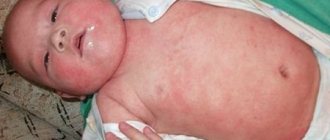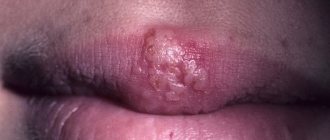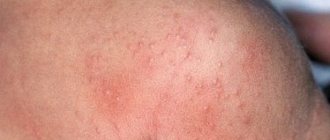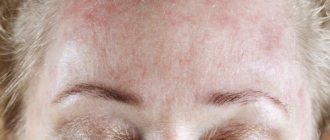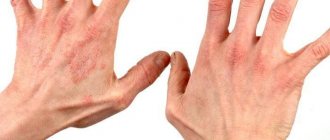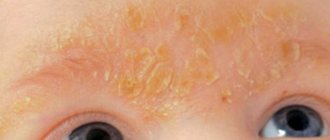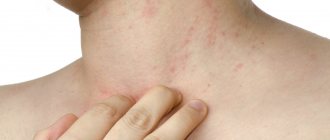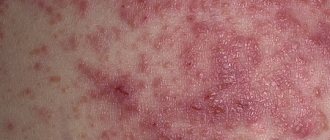What is Dühring's dermatitis?
Dühring's dermatitis herpetiformis is a chronically ongoing, periodically recurrent skin disease of a benign nature, the characteristic features of which are: true polymorphism of the rash and intense burning skin itching. In addition, an important distinguishing feature of this dermatitis is the presence of subepidermal granular deposits of immunoglobulin A.
This pathology is considered rare. Mostly people aged 30-45 years suffer from it, but cases of childhood morbidity cannot be ruled out. As for gender predisposition, the incidence among males is higher than among females.
Dermatitis occurs in paroxysms and can begin either acutely or subacutely. The disease itself most often lasts for many years, and therefore patients mentally and physically suffer greatly from skin manifestations, which can either disappear completely during remissions (the duration of which is impossible to predict) or not disappear at all.
With this pathology, there is hypersensitivity to iodides - taking drugs containing iodine can not only provoke the appearance of skin manifestations specific to Dühring's dermatitis, but also lead to an unsafe worsening of the existing clinical picture.
Dühring's dermatitis herpetiformis: photos, features, clinical picture of the disease
Dermatitis herpetiformis (photo) occurs in the form of a rash on the patient’s skin, the appearance of which is accompanied by burning and itching at the sites of injury. In terms of external signs, the rash is similar to herpes, so the disease is often interpreted as herpes dermatitis (photo).
There are several main types of disease:
- vesicular dermatitis;
- papular;
- urticariform;
- bullous
Dühring's dermatosis (photo) is considered a chronic disease characterized by seasonal exacerbations and recessions. The pathology is recurrent. Rashes usually form peculiar garlands, half rings and rings on the skin.
Causes of the disease
The exact cause of the development of Dühring's dermatitis has not yet been established. It is believed that this skin disease is one of the special forms of celiac disease. This is due to the fact that gluten-sensitive enteropathy in this type of dermatitis is identical in functional, clinical and morphological characteristics to that in celiac disease.
The only minor difference is the smoothness and mildness of intestinal symptoms. When consuming foods rich in gluten, there is a significant deterioration in the general condition of the patient and the severity of skin symptoms of dermatitis.
In addition, there are a number of factors contributing to the development of Dühring's dermatitis:
- insolation;
- genetic predisposition;
- malignant neoplasms;
- intercurrent diseases;
- pathological and physiological endocrine changes (pregnancy, menopause);
- vaccination;
- lymphogranulomatosis;
- toxemia;
- weakened immune system;
- helminthic infestations;
- inflammatory diseases of the digestive tract: ulcers, gastritis, colitis, etc.;
- viral and bacterial infections with a protracted course.
Due to the unknown cause of the development of the disease, you should be extremely careful with the above-mentioned provoking factors.
Causes and mechanism of development of pathology
The disease has been known for more than 130 years, but its causes and pathogenesis have not yet been fully established. In 1966 and subsequent years, reports began to appear of celiac disease among many patients with Dühring's dermatitis herpetiformis. Celiac disease, or gluten-sensitive enteropathy, is damage to the villi of the epithelium of the small intestine by the protein gluten or similar hordein, avenin, etc., contained in the gluten of cereal plants - barley, wheat, rye, oats. This intestinal pathology is often accompanied by symptoms of malabsorption.
Genetic theory
According to the results of family studies, 4-7% of patients with Dühring's dermatitis herpetiformis had immediate relatives with the same disease and a significantly higher percentage with relatives suffering from celiac disease. In addition, monozygotic twins were identified, one of whom suffers from gluten-sensitive enteropathy, and the second from dermatitis herpetiformis.
All these and many other facts served as the basis for the assumption of the genetic nature and similarities between these two pathological conditions. Confirmation is the presence in 90% of such patients on the sixth chromosome of various forms of the same gene, which determine the variant of development of the disease (Dühring's dermatitis or celiac disease).
Autoimmune theory of the pathogenesis of Dühring's dermatitis herpetiformis
Serological examination of affected areas of the skin using direct immunofluorescence techniques in most patients reveals fixed deposits of immunoglobulin “A” (IgA) at the junction of the epidermis with the dermis or in the papillary layer of the skin. IgA is an antibody and is located in the form of granules in the area and within the dermal papillae, located near the basement membrane.
These antibodies are directed against the structural components of the dermal papillae. Some patients have gluten-IgA complexes that also circulate in the blood. According to various data, in 30-100% of patients with Dühring's dermatitis herpetiformis without gastrointestinal symptoms in the mucous membrane of the small intestine, partial or complete atrophy of the villi of the epithelium of the mucous membrane of the small intestine is found, similar to celiac disease.
In this regard, the autoimmune theory of the pathogenesis of Dühring's dermatitis herpetiformis has become most widespread, according to which the mechanism of development of the pathology lies in autoimmune tissue damage.
Provoking factors
Thus, it is assumed that the genetic cause of Dühring's dermatitis herpetiformis is realized through an autoimmune mechanism in the presence of provoking factors - background diseases and disorders in the body. The main ones are:
- Consumption of a relatively significant amount of flour products and dishes with pearl barley, semolina and barley, starch, which contain gluten and similar protein components, as well as hypersensitivity to iodine, iodine preparations and seafood (contain iodine). In this regard, the diet for Dühring's dermatitis herpetiformis is the basis of pathogenetic therapy.
- Allergic reactions to vaccines and/or medications (less common).
- Autoimmune connective tissue diseases.
- Acute or chronic thyroiditis.
- Diabetes mellitus type I.
- Malignant tumors.
- Blood diseases (lymphogranulomatosis).
- Physiological changes in the endocrine system (during puberty, pregnancy, menopause).
- Viral infections, helminthic infestations and intoxication of the body.
- Exposure to ultraviolet rays and stress conditions.
Symptoms of the disease
Dühring's dermatitis can occur in two ways:
- develops slowly, gradually, with a gradual increase in the clinical picture;
- occurs sharply, suddenly, symptoms are pronounced from the very beginning of the disease.
On this topic
- Dermatitis
All about the symptoms and treatment of allergic dermatitis in adults
- Inna Viktorovna Zhikhoreva
- September 25, 2020
The clinical symptoms of Dühring's dermatitis are based on the following symptoms:
- Severe, intense, even burning itching, causing a lot of anxiety to the patient. Massive scratching leaves behind traces that mask the primary manifestations, thereby complicating the diagnosis of the disease. Traces of them may become impetiginized.
- temperature may rise to subfebrile levels.
- Abnormal bowel movements are noted: frequent diarrhea.
- Symptoms associated with dysfunction of the thyroid gland may occur
If treatment is stopped (if the therapeutic course is incomplete), small blisters may transform into large bullous blisters, followed by their opening and exposure of the hyperemic, inflamed fundus.
It is also not uncommon to see the appearance of eczematous rashes that tend to lichenify. These same changes can be observed even against the background of correct treatment in children and the elderly.
Favorite places for the localization of a polymorphic rash in dermatitis herpetiformis are almost the entire upper shoulder girdle, forearms and elbows (their extensor surfaces), scalp, face and neck, less often - knees and legs, buttocks. The rash is most often located on symmetrical areas of the skin.
On this topic
- Dermatitis
Effective methods for treating perioral dermatitis on the face
- Inna Viktorovna Zhikhoreva
- September 25, 2020
A polymorphic rash, represented by blisters, erythema, urticarial and papular elements, as well as herpetiform vesicles, can occur on both hyperemic and unchanged skin.
The bubbles have a flat cover and are elastic to the touch. Their contents at the initial stages of the development of the disease have a transparent color; as the pathological process progresses, it acquires more cloudy shades, sometimes it can become hemorrhagic or purulent-hemorrhagic. Elements of the rash tend to be ring-shaped and grouped.
With dermatosis herpetiformis, changes in the small intestine are observed, similar to those with celiac disease: villous atrophy, inflammatory infiltrates, disruption of the functioning of epithelial cells of the small intestine associated with a decrease in enzymatic activity. However, the general symptoms of celiac disease may be absent.
Symptoms
A distinctive feature of the disease is the polymorphism (variety) of rashes. Blisters, bubbles with transparent contents, papules with pink-red borders, smooth erythematous spots with clear contours can simultaneously appear on the skin. The elements of the rash are grouped and located symmetrically on the body. The epidermis underneath may be swollen and red, or externally unchanged.
More often, blisters with dermatitis are small, with a clear liquid inside. Darkening of the contents indicates the addition of a bacterial or viral infection. Over time, they open up and form crusts. During this period, the skin is very itchy and itchy, but you should not scratch it so as not to provoke erosion.
In addition to the skin symptoms of Dühring's dermatitis, patients complain of a slight increase in body temperature, weakness, drowsiness or, conversely, insomnia, copious gray loose stools, and nagging pain in the joints. Against this background, psychological problems develop (depression, neurosis).
Diagnostics
Diagnosis of Dühring's dermatosis can be based on examination data, patient complaints, as well as such laboratory and instrumental research methods as:
- Cytological examination from the bottom of the bladder. The fluid inside the bladder contains a high content of eosinophilic and neutrophilic leukocytes.
- Complete blood reveals pronounced eosinophilia.
- Histological examination of the bladder allows us to detect the histiocytic, lymphocytic, eosinophilic, neutrophilic composition of the marginal zones.
- Electron microscopy confirms the fact of the initial location of the bubble in the stratum corneum, in which the presence of necrobiotic changes in collagen fibers is noted.
- Direct immunofluorescence - it can be used to detect the presence of granular deposits of immunoglobulin.
- Test with iodides - performed by applying ointment with potassium iodide of 50% concentration to the forearm for a day under a compress. A positive result is indicated by the appearance of hyperemia and rash elements.
The diagnosis is established on the basis of all research methods that allow simultaneous differential diagnosis with diseases such as pemphigus vulgaris, bullous pemphigoid, etc.
What is herpes in children
Children have herpetic dermatitis, a pathology that some know as Dühring's disease - a disease that occurs in a chronic form, affecting skin tissue with a polymorphous rash.
The lesions are recorded not only superficially. Herpes simplex can be localized everywhere, including mucous tissues and internal organs. Typically, therapy lasts a long time and transfers the pathology to a latent state. Due to the fact that the immune system in children is not stable, relapses often occur for various reasons.
Herpes simplex in children is a common anthroponotic viral disease. It is usually classified as herpetic:
- eye disease;
- encephalitis;
- meningitis;
- vesicular dermatitis;
- eczema;
- disseminated disease;
- other forms of infection.
Treatment of dermatitis herpetiformis
The therapeutic effect on the disease is based on a number of therapeutic measures.
Pharmacotherapy:
- Sulfone drugs . The main representative of this group, used for Dühring's dermatitis, is dapsone. The dosage of the drug is prescribed on a strictly individual basis and varies between 50-150 mg per day. Initially, dapsone is prescribed for 5 days, then a break is taken (1-2 days), after which the five-day course is resumed. Once the desired clinical effect is achieved, the daily dosage of the drug is gradually reduced. To consolidate the results, about 2-4 therapeutic courses are recommended.
- Glucocorticosteroids (prednisolone, methylprednisolone, dexamethasone) - it is especially important to take drugs of this group in the first month of treatment with dapsone.
- Sulfapyridine or colchicine for dapsone intolerance.
- Vitamins – preference is given to B vitamins, folic acid. Ascorbic acid and rutoside.
- Antihistamines (claritin, tavegil, suprastin).
- Cyclosporine is used for torpid forms of the disease.
- Local treatment with warm baths with potassium permanganate, as well as ointments, gels or creams with hydrocortisone and polidocanol.
- Gluten-free diet.
Positive results from treatment can only be achieved by full compliance with the complex effects, as well as continuity of basic therapy.
Treatment
Goals of therapy: eliminate skin rashes, prevent affected areas from becoming infected with secondary infections, achieve stable remission, teach the patient methods of prevention.
The basis of recovery is the elimination of gluten-containing foods from the diet. The diet prohibits pasta, flour products, beer, kvass, soups with legumes, cabbage, seafood, breaded and dough-based dishes, and desserts. Strict adherence to proper nutrition can reduce the frequency of relapses to a minimum.
Drug treatment includes taking the following medications:
- antihistamines to relieve itching and allergy symptoms;
- anti-leprosy (“Ditsifon”, “Dapson”);
- sedatives of plant origin;
- vitamins (ascorbic acid, iron, rutin);
- detoxification (thioctic acid).
Severe dermatitis requires the use of systemic glucocorticosteroids, for example, Triamcinolone, Prednisolone or Dexamethasone. If they do not help, then autohemotherapy (blood purification) or blood and plasma transfusion is indicated. When a bacterial infection occurs, sulfonamides are prescribed.
Diet
For Dühring's dermatitis herpetiformis, adherence to a gluten-free diet is considered mandatory. Patients who exclude from their diet foods rich in gluten or containing iodine salts often achieve the disappearance of rashes and a reduction in the dosage of pharmacological medications taken.
On this topic
- Dermatitis
How to prevent the occurrence of toxic-allergic dermatitis
- Irina Nasredinovna Nachoeva
- September 24, 2020
With this disease, it is recommended to exclude all foods containing gluten:
- bread and all flour products;
- dough products and cereals (barley, oatmeal, pearl barley and semolina);
- products made from wheat, rye, bran, oats, barley;
- breaded meat products, any fish and poultry;
- sausages containing bread fillers;
- soups containing prohibited varieties of starch and flour, as well as lentils, cabbage, beans, peas, and cereals;
- kvass , beer;
- chocolate with filling, puddings, ice cream, churchkhela, cream, marzipan;
- coffee drinks, which may contain rye, barley, oats;
- sauces, as well as syrups prepared with the addition of flour;
- seafood (including sea fish, shellfish, squid, shrimp, seaweed, crabs).
Permitted products include:
- bread prepared with the addition of starch or corn flour;
- baked products made from rice, soy, corn flour;
- products made from rice, buckwheat, corn and soybean cereals;
- all types of meat without additives;
- River fish;
- bird;
- milk and fermented milk products;
- eggs;
- decoctions and broths, vegetable soups;
- tea, cocoa, ground natural coffee;
- jelly, compote, mineral waters without bromine and iodine;
- butter, peanut and vegetable oil, margarine;
- nuts, spices;
- greens, vegetables and fruits.
The diet does not exclude the occurrence of relapses, but significantly reduces their number and the intensity of the symptoms of the disease.
Treatment and diet
Treatment of Dühring's dermatitis should be comprehensive, combining medicinal and non-medicinal methods.
Patients with Dühring's dermatitis need to follow a certain diet. Since they have gluten and iodine intolerance, grain products and seafood are excluded from the diet. Therefore, the following should be excluded from the diet:
- any pastries;
- pasta;
- cereals;
- products containing malt;
- all types of cabbage, legumes;
- breaded products;
- minced meat, if it contains bread.
You will have to give up cereal products, especially wheat, rye and barley.
What can patients with Dühring's dermatitis eat? In fact, the diet of such people is quite extensive. Eliminating large amounts of foods does not mean that a person will lack nutrients. A complete diet can be made from the following products:
- fruits and berries;
- greens and almost all types of vegetables;
- honey;
- corn and buckwheat cereals;
- tea, coffee, herbal drinks.
Treatment of Dühring's dermatitis with diet is prescribed for life.
Complications of the disease
In the absence of adequate rational or untimely treatment, some complications may develop. The most common complications of Dühring's dermatitis include:
- pigmentation of the skin in places where the elements of the rash are localized after their resolution;
- dyschromia - a change in skin color depending on the predominance of a particular pigment;
- formation of scars from scratching;
- atrophy ;
- the addition of secondary infections not only prolonging the course of the disease, but also aggravating the general condition of the patient. In this case, additional treatment with antibiotic therapy is indicated.
In order to avoid unpleasant complications, it is strongly recommended to start treatment in a timely manner and unconditionally follow all doctor’s instructions.
Prevention
The virus that provokes the development of herpes dermatitis is always present in the human body, but is activated only when immunity decreases. Therefore, the most important preventive measure is to support the immune system. For this purpose, it is recommended to take vitamin supplements regularly (twice a year), and pay attention to your own diet and lifestyle.
Poor nutrition, chronic stress and bad habits can provoke skin damage to the virus.
Having detected the appearance of the first bubbles, it is necessary to begin treatment as soon as possible. If a child develops dermatitis, it is very important to explain to the child not to touch the sore skin, otherwise an infection may occur and the disease may worsen. Timely treatment will effectively get rid of the problem and prevent its recurrence.
Disease prognosis
Strict adherence to the treatment regimen and dietary nutrition significantly improves the patient’s condition, reducing the likelihood of frequent relapses. However, it is not uncommon for cases when, against the background of treatment, new elements of the rash continue to appear and the disease progresses.
The course of the disease itself is protracted, remissions occur spontaneously.
In childhood there is a positive tendency towards healing.
On this topic
- Dermatitis
All about seborrheic dermatitis
- Irina Nasredinovna Nachoeva
- September 3, 2020
If elements of a rash appear on the skin, you should consult a doctor as soon as possible. You should not wait for the pathological process to progress and self-medicate. Timely diagnosis of the disease and initiation of correct therapy is the key to success and recovery.
In the case of Dühring's dermatitis, it is important to complete the full course of the prescribed pharmacological treatment without interruptions, in addition to those prescribed by the attending physician, as well as adherence to the dietary regimen throughout the entire period. Only by fulfilling these conditions can the frequency of relapses and exacerbations of the disease be minimized.
Causes of dermatitis
The herpes virus can live in the human body for many years in an inactive state, that is, without manifesting itself in any way. However, under the influence of certain factors, the process of active reproduction of the virus may begin, which results in herpes dermatitis.
The following factors can trigger the development of dermatitis:
- decreased immunity;
- suffered severe infectious and viral diseases;
- metabolic changes;
- hormonal disorders.
The risk of virus activation increases many times over the background of stress and chronic fatigue. Chronic diseases of the gastrointestinal tract and malignant neoplasms may also be involved in the appearance of skin lesions.
Herpetic dermatitis in children can be caused by metabolic disorders and decreased immunity.
Symptoms of herpetic dermatitis
The most basic symptom of the disease: rash on the lips. In rare cases, herpetic plaques, if not properly treated, spread to the genitals and can affect vital organs, which aggravates the course of the disease and requires more serious treatment.
The virus is present in more than 90% of people, most of whom have had herpes at least once in their lives and are hidden carriers of the virus.
note
The disease becomes active only when certain conditions are created for it. If a person has normal immunity, the herpes virus is not dangerous for him.
With the classic manifestation of the disease, symptoms disappear within one and a half to two weeks. In frequent cases, in the absence of proper treatment, or interruption of therapy without its proper completion, the pathology can go into the relapse stage, with periodic exacerbations.
The danger of the virus is its rapid spread. The survival of pathogenic microorganisms is perfectly preserved at extremely low or high temperatures during the day. The herpes virus enters the body of a healthy person as a result of direct contact with the virus carrier, so infection most often occurs through contact. You can easily become infected by touching skin affected by herpes, using personal hygiene items of a sick person, during intimacy, or through bedding. Therefore, we can conclude: herpetic vesicular dermatitis is contagious!
Diagnosis of the disease
When the first symptoms similar to the disease in question appear, you should immediately consult a doctor.
A professional dermatologist should prescribe a number of diagnostic procedures.
Often, the diagnosis of the disease is carried out through:
- determining the level of eosinophils in the blood and in papules (in case of disease this value is high);
- performing the Yaddason test (if a reaction to iodine occurs, we can talk about the presence of dermatitis);
- works of histology and immunofluorescence studies.
What is herpetic vesicular dermatitis and how to treat it
Herpetic dermatitis is a disease of a permanent, that is, chronic nature, which develops due to exposure to the herpes virus on the body.
Its carriers today are about 90% of the world's population. And only 1 in 10 people have never encountered an infection. Recognizing vesicular herpetic dermatitis is quite simple. Its main symptom is the appearance of blisters. The infection most often appears on the arms, legs, face - wings of the nose, lips, mucous membranes.
Less often it can be observed on the ears and genitals.
Herpes simplex dermatitis develops due to exposure to the herpes simplex virus. After entering the blood, and this happens through contact or endogenous (airborne) routes, the virus tends to the nerve fibers of the spinal cord. There he remains in a dormant state. Unfortunately, once the herpes virus enters the human body, it will never leave it.
Only one factor can become an impetus for its awakening - weakening of the immune system. The body's defenses stop working for several reasons:
- constant nervous excitement, stressful conditions;
- improper, irrational nutrition;
- lack of vitamins;
- exacerbation of chronic diseases;
- the presence of oncological pathologies, diabetes mellitus;
- frequent exposure to ARVI;
- hormonal disbalance;
- gastrointestinal diseases;
- hypothermia, overheating;
- reluctance to move or play sports;
- physical and mental exhaustion of the body.
All these factors provoke a decline in immunity. As soon as this happens, the virus is activated, begins to multiply and moves closer to the skin.
Herpes simplex virus
Symptoms
The symptoms of the disease are as follows. After activation of the virus, an infected person experiences general malaise, manifested in weakness and fatigue. Sometimes the disease is accompanied by an increase in body temperature. At the site of the lesion, the skin itches and tingles.
Then, on about 2-3 days, small blisters appear on the skin - vesicles, outlined by a red rim. It contains a clear liquid that becomes cloudy over time. There can be many such formations.
There is a possibility of their unification.
Then the blisters burst, and in their place there remain ulcerated areas, which are subsequently covered with crusts. After this, they disappear, and in their place dark spots remain, which disappear after a while.
Normally, external manifestations of herpes should disappear within 5-10 days. If the affected areas of the skin do not heal for a long time, then there is a high probability of a secondary bacterial or fungal infection. In addition, there is a high risk of scarring.
Features of the course of the disease in a child are that the baby refuses to eat and drink, is very capricious, and has problems sleeping.
Most often in children, vesicular herpetic dermatitis manifests itself in the form of stomatitis, that is, the rash is localized on the oral mucosa.
The process is necessarily accompanied by an increase in body temperature to high levels. In rare cases, diarrhea and weight loss are observed.
Dermatitis appears on the legs, arms, face, genitals, buttocks, shoulders, and mucous membranes. Can affect any part of the body. The exception is the palms and feet.
What does it look like
As already mentioned, the herpes virus can appear on different parts of the body. Depending on the location of the inflammatory process, the disease may look different.
- Eyes – herpes of the conjunctiva, cornea, corneal ulcer, vascular damage, damage to the deep layers.
- Mucous membranes of the mouth - stomatitis, gingivitis, tonsillitis.
- Mucous membranes of the genital organs - damage to the vagina, urethral canal, glans penis, vulva, etc.
- Skin – eczema, dermatitis.
Herpetic dermatitis
Diagnostics
Research activities are based on external examination of the rash and laboratory tests. The main diagnostic method is to take a scraping from the lesion. Next, the biological material is examined under a microscope.
Diagnosis of the disease is also carried out using blood sampling. In this case, antibodies to the herpes virus are detected.
If rashes occur, you should consult a dermatologist. If relapses occur frequently, you need to visit an immunologist.
Treatment
In case of illness, complex therapy is necessarily prescribed. You can't get by with drugs alone. It is important to completely reconsider your lifestyle. It is necessary to maintain immunity, provide adequate nutrition, etc.
As for drug treatment, it is prescribed depending on the severity of the symptoms of the disease, the frequency of relapses, the general condition of the infected person and is based on the intake and application of antiviral drugs, immunomodulating agents, etc. to the skin.
Treatment of dermatitis is based on taking antiviral drugs to reduce the frequency of exacerbations and reduce the intensity of symptoms. For this purpose they prescribe:
- "Acyclovir".
- "Famvir."
- "Valacyclovir."
- "Valtrex".
Valtrex and Famvir
The duration of drug treatment is 5-7 days.
Immunosubstitution therapy is mandatory. The duration of therapy will directly depend on the patient’s condition and the intensity of the disease manifestations. The best immunomodulatory drugs are: Cycloferon, Lykopid, Ridostin.
Local treatment is also used for herpetic vesicular dermatitis. The following are considered effective antiviral ointments:
- "Acyclovir".
- "Pentsivir".
- "Fenistil".
- "Zovirax".
Acyclovir and Zovirax
To dry out the rash and quickly heal the affected areas of the skin, local sulfur-based products are prescribed. For large lesions, the use of corticosteroids is recommended.
There are many treatment methods for herpetic dermatitis. Thus, to prevent the development of secondary infection, it is recommended to use antiseptic drugs. In addition, physiotherapeutic and hardware methods - ultraviolet irradiation, infrared irradiation, laser therapy - are effective in combating the disease.
Traditional therapy
Effective folk remedies against herpetic dermatitis are:
- a decoction of celandine, string, sea buckthorn, knotweed, calendula and wormwood - applied to the affected skin;
- aloe juice, celandine, garlic, sea buckthorn oil;
- to maintain immunity - tincture based on echinacea, nut peels (green), tea with lemon, honey, rose hips, black currant leaves;
- a mixture of lard and dried, crushed belladonna leaves (2:1);
- Corvalol lotions, rinsing the mouth with hydrogen peroxide (for stomatitis);
- lotions made from laundry soap, toothpaste, sulfur, raw chicken protein.
Prevention
To resist infection with the herpes virus, you should avoid any contact with an infected person and do not use his personal belongings.
Relapses can be avoided by maintaining immunity.
Strengthening the body's protective functions is based on proper nutrition, exercise, avoidance of stress, hypothermia, overheating, and timely treatment of chronic diseases.
Women who are preparing to become mothers should also take care of prevention. The fact is that herpetic dermatitis is very dangerous for the fetus and newborn baby. Therefore, tests to detect infections and their timely treatment are very important even at the stage of planning a child.
Herpes simplex virus - home treatment
